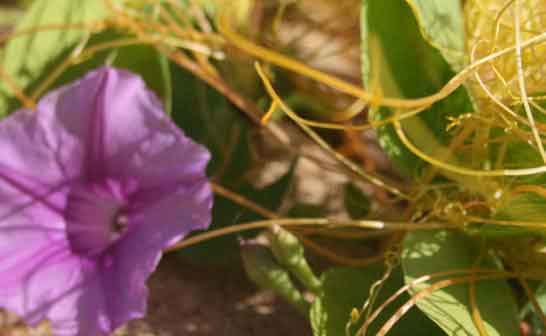Floral emblems of the islands: Maui’s non-native rose
By: Tamara Sherrill

growing on purple Pohuehue.
If you’ve heard about the lei flower or plant representing each Hawaiian island, you may have noticed that most are native. Maui’s flower, the Lokelani Rose, is the only post-European contact plant. How did this come about?
A Joint Resolution passed by the Territory of Hawai‘i in 1923 named the PUA ALOLO (Hibiscus) as the flower emblem of the state; this same Resolution also named “local flowers” that had previously been adopted for single island emblems as:
Hawai‘i
PUA LEHUA
(‘Ohia Lehua; the endemic Metrosideros sp.)
O‘ahu
PUA ILIMA
(‘Ilima; the indigenous Sida fallax)
Maui
LOKELANI
(an introduced pink Rose;
Rosa damascena, R. chinensis, or a hybrid)
Kaua‘i
MOKIHANA
(Mokihana, Mokehana, Alani;
the Kauai endemic Melicope anisata)
Molokai
PUA KUKUI
(Kukui; the Polynesian introduced
Aleurites moluccana)
Lana‘i
KAUNAOA
(Kauna‘oa; the endemic
Cuscuta sandwichiana)
Kaho‘olawe
HINAHINA
(Hinahina; the endemic
Heliotropium anomalum var. argenteum)
Later, it came to be known that Ni‘ihau had chosen the white PUPU shell as their island emblem.

Choosing Hibiscus to represent the state began with the first Outdoor Circle group established on O‘ahu in 1912. In the 1920’s they advocated for underground wiring, landscaping for military installations, the elimination of billboards, and to promote the adoption of a Hawaiian flower. This led to the Joint Resolution by the Territorial Legislature that designated Hibiscus, with no species specified, as the official floral emblem of Hawai‘i. For many years, the Chinese red Hibiscus and other colors were used. It wasn’t until 1988, long after statehood, that the Legislature amended the Revised Statutes to designate the endemic endangered Hibiscus brackenridgei as the official Hawaiian flower. Act 272 of the 1959 Territorial Legislature choose the Kukui (Aleurites moluccana) as Hawai‘i’s official state tree, designating it as “native”, though it is actually a canoe plant brought by the first Polynesian settlers.
So why did Maui come to be symbolized by a rose? Our board member Bob Hobdy writes,
“There has been so much speculation over the years as to what the Lokelani Rose was/is and what it looked like. Many who live on older properties claim that they have it, but when you look at them, they all look different. Inez Ashdown, back in the 1970’s, stated that there were three types she remembered from her childhood: the ‘Luau rose’ which was a dark red rose; the ‘Halona rose’ which was a faintly pink and white rose that grew in upper Lahaina; and the ‘Lokelani rose’ which was pink.” Marie Neal, writing in her book in 1965, In Gardens of Hawai‘i, said that the Lokelani rose was either Rosa damascena, Rosa chinensis or an unspecified hybrid. Bob speculated, “I suspect that it was a wonderfully fragrant rose growing on the properties of some prominent individuals on Maui that would have led to its selection over a native species such as the iconic Haleakala silversword.”
Bob notes that the Damask type shrub rose he has seen still growing on Maui have a wonderful fragrance but drop their petals quickly when picked, making them unsuitable for lei.
At some point colors became associated with each island based on the original floral emblems, with the Big Island associated with red, O‘ahu yellow, Maui pink, Kaua‘i purple, Moloka‘i green, Lana‘i orange, Kaho‘olawe silver-gray, and Ni‘ihau white.
Although the Lokelani Rose was obviously beloved, it has been uncommon for many years and there is confusion about which rose still growing is the true Lokelani. If we were to choose a new, perhaps native plant emblem that maintains our “pink” identity and represents Maui Island, what would it be? Post your thoughts on social media using the hashtag #FloralEmblemForMaui.
2 Replies to “Floral emblems of the islands: Maui’s non-native rose”
Comments are closed.


What variety has the Lokelani attributes but is not such a delicate variety, but a hardier variety more suitable for lei making.
We like ‘iliahi. Specifically Santalum haleakalae var. haleakalae, found only on Maui. See photos here: http://www.starrenvironmental.com/images/search/?q=Santalum+haleakalae+var.+haleakalae